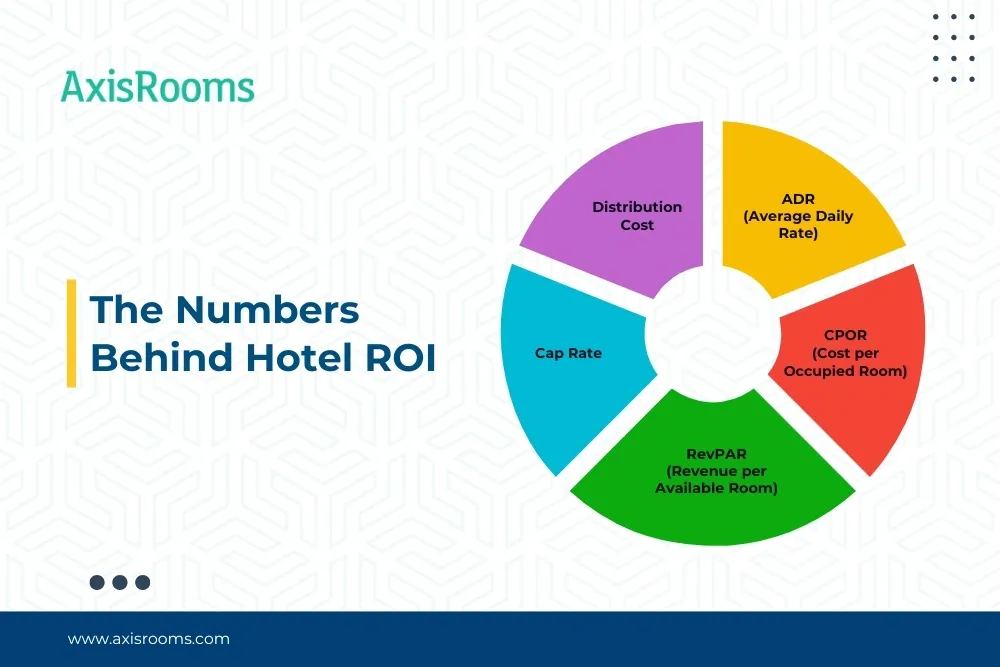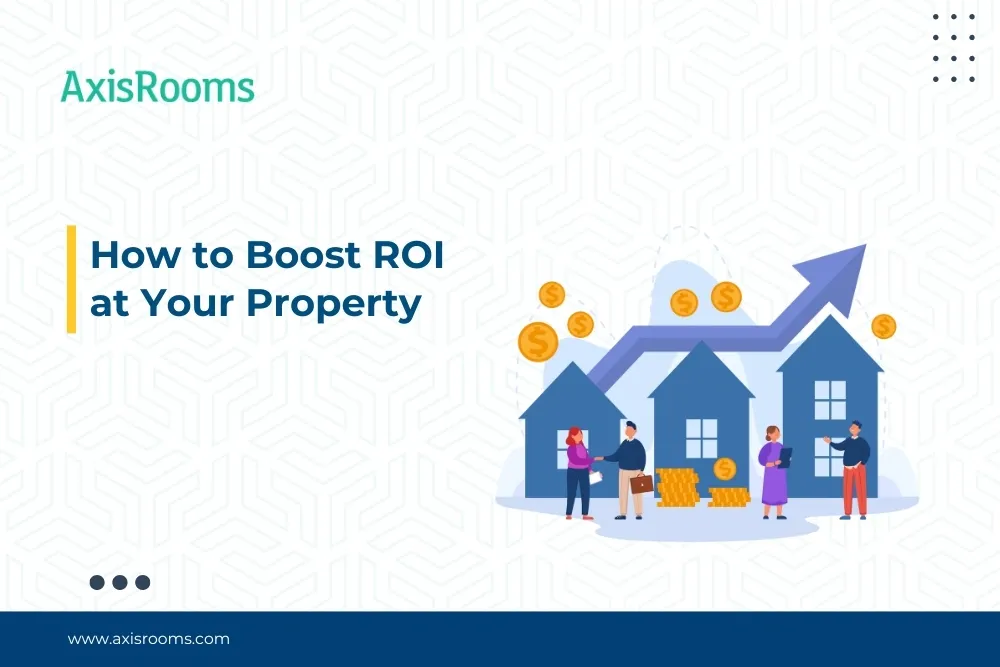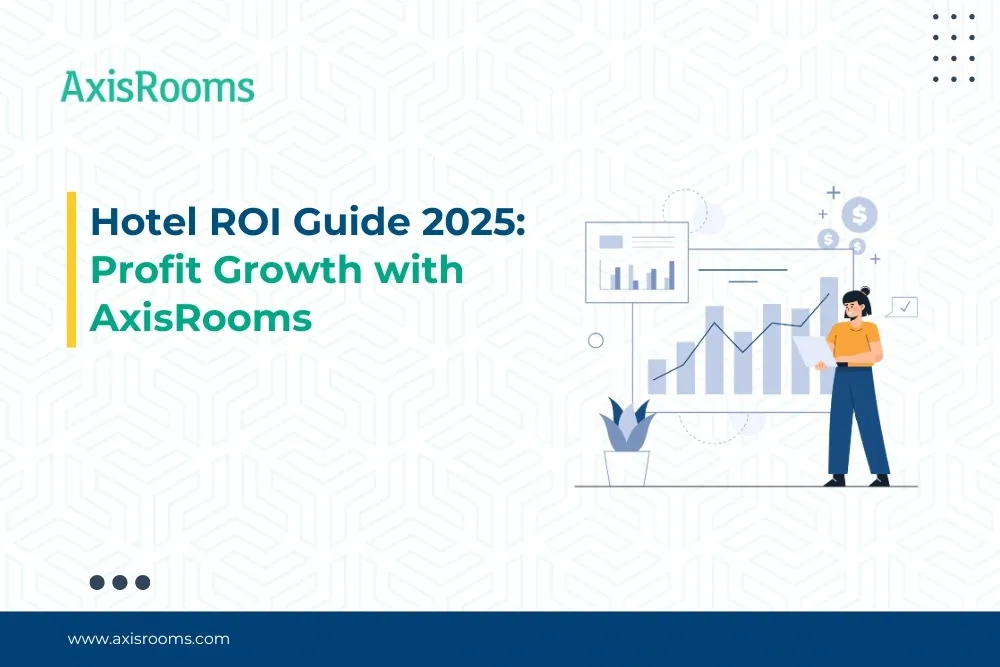Why ROI Isn’t Just a Number — It’s Your Hotel’s Reality Check
If you run a hotel, you already know how busy things can get — checking in guests, updating OTAs, managing staff, balancing rate parity. But here’s the uncomfortable truth: even if your rooms are full, your hotel may not be profitable.
That’s where Hotel ROI (Return on Investment) steps in.
ROI doesn’t care how many channels you’re listed on or how trendy your lobby looks. It answers the only question that truly matters —
“Is my hotel making enough profit compared to what I’ve spent on it?”
This guide isn’t about generic accounting formulas. It’s a practical roadmap designed for hotel owners, GMs, and revenue heads who want to stop guessing and start measuring what really drives growth. We’ll show you how to calculate ROI, which numbers to track, and how to improve your returns using AxisRooms’ Channel Manager, Booking Engine, and Revenue Management Services.
If you’re ready to turn busy operations into better profits, let’s dive in.
What Is Hotel ROI and Why It Matters
ROI is a simple formula — your annual profit divided by the total money you’ve invested in your hotel, multiplied by 100. For example, if you make ₹20,00,000 in profit annually from a ₹1.5 crore investment, your ROI is 13.3%.
In the hotel industry, ROI is not just a number. It’s a reflection of how well your hotel is being managed. A healthy ROI (typically 8–15%) means your hotel is growing and your investment is paying off.
The Numbers Behind Hotel ROI

- RevPAR (Revenue per Available Room) is calculated by dividing total room revenue by total rooms available.
Example: ₹40,000 room revenue ÷ 20 rooms = ₹2,000 RevPAR.
If ADR is ₹4,000, this indicates 50% occupancy. It's one of the most telling indicators of property performance, not just rate levels.
- ADR (Average Daily Rate) shows how much revenue you earn from each room sold. If ADR rises but RevPAR doesn’t, occupancy may be falling — a red flag for revenue managers.
- CPOR (Cost per Occupied Room) measures your cost per guest night.
Example: ₹100,000 operating cost ÷ 500 occupied rooms = ₹200 CPOR.
High CPOR indicates inefficiency and lower margins.
- Cap Rate reflects the return on your hotel asset, calculated by dividing Net Operating Income by current market value. It helps buyers and investors assess a property’s return potential.
- Distribution Cost is often hidden in OTA commissions, platform fees, and missed upsell opportunities. Reliance on OTAs for 90% of bookings can cost up to 25% of revenue in commissions alone.
How to Calculate and Improve Hotel ROI
Calculating ROI is easy. Just follow these steps:
- Add up your total investment — include everything: property value or lease, furnishing, renovations, PMS tools, and marketing setup.
- Calculate your annual net profit — that’s total revenue (from rooms, F&B, spa, etc.) minus operating costs.
- Use the ROI formula: ROI=(Net ProfitTotal Investment)×100ROI = \left( \frac{\text{Net Profit}}{\text{Total Investment}} \right) \times 100
Once you’ve calculated your ROI, the next step is optimization. This is where many hotels struggle — especially with challenges like manual rate updates, high OTA dependency, and static pricing.
How AxisRooms Helps Hoteliers Boost ROI
Channel Manager: Reduce Work, Increase Occupancy
Managing multiple OTAs manually eats up staff time and often leads to overbookings or errors. AxisRooms’ Channel Manager automates this process — syncing inventory and rates across all your connected platforms in real-time. That means less manual effort, fewer double bookings, and more accurate pricing across the board.
Booking Engine: Drive More Direct Bookings
With a mobile-friendly, commission-free booking engine directly on your website, you can encourage guests to book without involving third-party OTAs. AxisRooms’ booking engine is easy to use, works on all devices, and even supports upselling, promo codes, and seamless OTA integrations, ensuring rate parity and real-time inventory sync across all platforms.
Revenue Management: Smarter Pricing = Higher Profit
Rather than using static rates throughout the year, AxisRooms’ revenue management tools help you price rooms based on demand, season, and competition. This ensures you never undercharge during high demand or overcharge during quiet periods.
AxisRooms RMS: A Revenue Strategy Built for Independent Hotels
Instead of just giving you software, AxisRooms pairs advanced revenue tools with dedicated specialists who actively manage your pricing. It’s ideal for efficient revenue management strategies for independent hotels that want data-backed results without needing a full-time revenue team.
Even better, AxisRooms RMS is built to work smoothly with your existing tech — thanks to smart PMS integrations, you get real-time rate updates and insights without manual data transfers.
Hotels using AxisRooms RMS often report RevPAR improvements of 15–25% within a few months, along with better pricing control and fewer missed opportunities during peak seasons.
ROI Before and After AxisRooms: Real Hotel Case
This case reflects results from a leisure hotel that adopted AxisRooms’ full suite: Channel Manager, Booking Engine, and RMS.
How to Boost ROI at Your Property

To truly improve ROI, it’s not just about checking off a list. You need to approach your hotel operations with a mindset of continuous optimization.
Start by using a channel manager to cut down on human error, save staff time, and avoid overbookings. Focus on direct bookings — the more guests who book directly on your website, the less you pay in commission.
Track your RevPAR, ADR, and CPOR every month. Adjust your pricing based on demand and season. Use forecasting tools to prepare for high-traffic dates or low seasons. Review OTA performance quarterly and focus your energy on the ones that deliver profit, not just bookings.
By aligning your distribution, pricing, and tech setup, you build a stronger hotel marketing strategy that supports long-term profitability.
Frequently Asked Questions on Hotel ROI
Q1 : How often should I calculate ROI for my hotel?
A: At a minimum, annually. For better control, track profit and key metrics monthly or quarterly.
Q2 : Is ROI more important than occupancy?
A: Yes. High occupancy with low ADR may still result in poor profitability. ROI balances cost, rate, and volume.
Q3 : Can AxisRooms help small independent hotels?
A: Absolutely. It was built for independent operators who want enterprise-grade revenue strategies with minimal complexity.
Q4 : How long until I see ROI improvements after using AxisRooms?
A: Most hotels report improved efficiency and bookings within the first 60–90 days.
Final Thoughts: Turn Everyday Operations into Long-Term Gains
Improving ROI isn’t just about cutting costs — it’s about making smarter decisions. With AxisRooms, your hotel gains tools and expert support that turn everyday operations into lasting profit.
Whether it’s automating OTA updates, increasing direct reservations, or managing pricing dynamically, AxisRooms helps you make the most of what you already have — and set up your hotel for sustainable success.
Download Your Free ROI & Cap Rate Calculator
Start measuring your performance and take your profitability to the next level.
Book a free demo with AxisRooms today to explore tools that are tailored to grow your hotel’s revenue.


